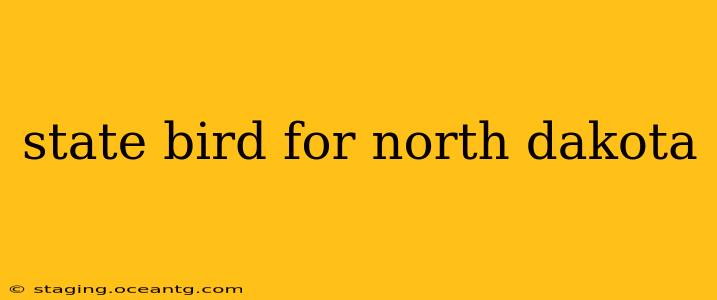North Dakota's official state bird is the Western Meadowlark (Sturnella neglecta). This vibrant and melodious bird is a beloved symbol of the state's vast prairies and grasslands. Its cheerful song and striking appearance make it a captivating sight and sound for residents and visitors alike. But what makes the Western Meadowlark so special, and why was it chosen to represent North Dakota? Let's delve deeper.
Why is the Western Meadowlark North Dakota's State Bird?
The Western Meadowlark was officially adopted as the state bird of North Dakota in 1989. Its selection wasn't arbitrary; it reflects a deep connection to the state's identity and landscape. The bird is abundant throughout the state, thriving in the open grasslands and prairies that define much of North Dakota's geography. Its presence is a constant reminder of the state's natural beauty and the rich biodiversity that flourishes within its borders.
Beyond its abundance, the Western Meadowlark's distinctive song also played a significant role in its selection. Its clear, flute-like melody is a quintessential sound of the North Dakota landscape, often heard echoing across the plains. This beautiful song resonated with the state's residents, solidifying its place as a cherished symbol.
What Does the Western Meadowlark Look Like?
The Western Meadowlark boasts a striking appearance that is easy to recognize. It's predominantly brown on its back, providing excellent camouflage amidst the grasses and fields. Its underside, however, is a bright yellow, punctuated by a distinctive black V-shaped marking on its breast. This vibrant yellow contrasts beautifully with the more subdued tones of its back. Its long, pointed beak is perfectly adapted for probing the ground in search of insects and seeds.
Where Can I See Western Meadowlarks in North Dakota?
Western Meadowlarks are widespread throughout North Dakota, particularly in areas with grasslands, prairies, and open fields. You're likely to spot them in pastures, along roadsides, and even in some agricultural areas. They are generally ground-dwelling birds, preferring to forage for food in the open rather than in dense vegetation. National parks and wildlife refuges across the state offer excellent opportunities for observing these beautiful birds.
What are the differences between Eastern and Western Meadowlarks?
This is a common question, as both species are very similar. The key difference lies in their song and breast markings. The Western Meadowlark's song is generally considered more melodious and flute-like, while the Eastern Meadowlark's song is often described as slightly more complex and less musical. The black V-shaped marking on the breast is also more pronounced in the Western Meadowlark.
What are the conservation status of Western Meadowlarks?
While not currently considered threatened or endangered, habitat loss due to agricultural expansion and urbanization poses a potential threat to Western Meadowlark populations. Conservation efforts focus on preserving and restoring grassland habitats to ensure the long-term survival of this iconic bird.
What is the significance of the state bird for North Dakota?
The Western Meadowlark's status as the state bird goes beyond simple identification. It symbolizes the spirit of North Dakota – its resilience, its beauty, and its connection to the land. It’s a reminder of the state’s rich natural heritage and serves as a potent emblem of pride for its residents. The bird's popularity and recognition further contribute to the state's tourism and cultural identity.
In conclusion, the Western Meadowlark's selection as North Dakota's state bird is a fitting tribute to this beautiful and melodic creature that embodies the spirit and landscape of the state. Its vibrant presence and beautiful song enrich the North Dakota experience, making it a true symbol of pride and natural heritage.
